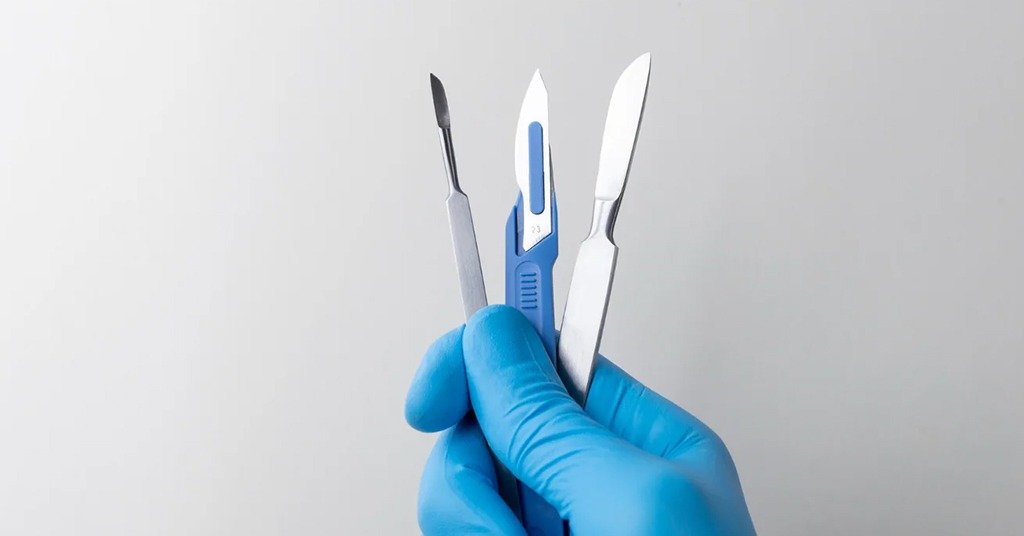Introduction
Veterinary surgical scalpels are the cornerstone of animal procedures, enabling precise incisions from routine spays to complex orthopedic repairs. Choosing the right veterinary surgical scalpel ensures clean cuts, minimal tissue trauma, and faster recovery for animals. At Surgment, our FDA, CE, and ISO-compliant veterinary scalpels are crafted from premium stainless steel, designed for durability and accuracy in small animal, equine, and exotic practices. This comprehensive guide explores scalpel types, applications, selection criteria, maintenance best practices, and trends, empowering veterinarians to achieve optimal surgical outcomes in 2025.
Why Precision Scalpels Matter
Choosing high-quality veterinary surgical scalpels minimizes trauma and improves healing outcomes. A 2024 Veterinary Surgery study found that high-quality scalpels reduce tissue trauma by 15%, lowering infection risks and recovery times. Dull or poorly designed scalpels can cause jagged cuts, excessive bleeding, or delayed healing, compromising outcomes. For example, in feline spays, a precise scalpel minimizes abdominal trauma, while in orthopedic surgery, accuracy prevents damage to surrounding tissues. Surgment’s scalpels are engineered for sharpness and control, ensuring reliable performance.
Types of Veterinary Scalpels
- Disposable Scalpels: Single-use scalpels with fixed blades ensure sterility and convenience, ideal for minor procedures or field surgeries.
- Reusable Scalpels: Handles (e.g., #3, #4) with detachable blades (e.g., #10, #11, #15) offer versatility and cost-effectiveness for frequent use.
- Safety Scalpels: Retractable or shielded blades reduce accidental cuts, enhancing staff safety.
- Micro Scalpels: Fine-tipped blades for delicate procedures, such as ophthalmic or exotic animal surgeries.
Applications in Veterinary Surgery
- Soft Tissue Surgery: Scalpels create clean incisions for spays, castrations, or tumor removals, minimizing trauma.
- Orthopedic Surgery: Precise blades support bone exposure or tissue dissection in fracture repairs.
- Ophthalmic Surgery: Micro scalpels enable delicate incisions for corneal or eyelid procedures.
- Emergency Procedures: Disposable scalpels provide quick, sterile access for trauma cases.
How to Choose Veterinary Scalpels
- Blade Type: Select blades suited to your procedure (e.g., #10 for general surgery, #15 for fine work).
- Material Quality: Stainless steel or carbon steel ensures sharpness and durability. Surgment’s scalpels use premium materials.
- Ergonomics: Lightweight, non-slip handles reduce fatigue and improve control.
- Certifications: FDA, CE, and ISO compliance ensures safety and quality.
- Warranty: A lifetime guarantee, like Surgment’s, protects reusable handles.
- Sterilization Compatibility: Ensure blades and handles withstand autoclaving or chemical sterilization.
Case Study: Enhancing Surgery with Surgment’s Scalpels
In 2024, a small-animal clinic in Oregon adopted Surgment’s FDA-compliant reusable scalpels for its surgical suite. Previously, disposable scalpels dulled mid-procedure, leading to uneven incisions and longer recovery times. After switching to Surgment’s precision scalpels, the clinic reported a 20% reduction in surgical times and a 10% decrease in postoperative infections, attributed to cleaner cuts and improved control. This case demonstrates the value of quality scalpels in veterinary care
Maintenance Best Practices
- Cleaning: To extend the life of your veterinary surgical scalpels, follow these best practices. Use enzymatic cleaners in an ultrasonic bath for 5–10 minutes.
- Sterilization: Autoclave reusable handles at 134°C for 3–5 minutes. Dispose of single-use blades safely.
- Sharpening: Replace detachable blades regularly; sharpen reusable blades every 6–12 months if applicable.
- Storage: Store handles in sterile, padded trays to prevent damage. Use moisture-control packs to avoid corrosion.
- Inspection: Check for dullness, corrosion, or loose fittings before use. Replace damaged scalpels to ensure safety.
Industry Trends in Veterinary Scalpels for 2025
- Safety Features: Retractable blades and ergonomic handles enhance staff safety.
- Eco-Friendly Options: Reusable handles with recyclable blades reduce waste.
- Micro-Precision: Advanced blades for exotic or ophthalmic surgeries gain traction.
- Smart Scalpels: Sensors for cutting depth are emerging, though costly.
Common Challenges and Solutions
- Blade Dullness: Use high-quality blades and replace regularly to maintain sharpness.
- Cost Concerns: Reusable scalpels save money long-term. Surgment offers competitive pricing.
- Staff Safety: Train staff on safe handling and disposal to prevent injuries.
Tips for Veterinarians
- Stock Versatile Blades: Keep a range of blade sizes (e.g., #10, #15) for different procedures.
- Train Staff: Ensure assistants handle and sterilize scalpels correctly.
- Stay Updated: With the latest scalpel innovations through resources like Today’s Veterinary Practice or the AVMA surgical guidelines..
Frequently Asked Questions (FAQs)
- When should I use disposable vs. reusable scalpels?
- Disposable for minor or field surgeries; reusable for frequent, complex procedures with proper sterilization.
- How often should I replace scalpel blades?
- Replace detachable blades after each procedure or when dull. Dispose of single-use scalpels safely.
- Are micro scalpels necessary for small animals?
- They’re ideal for delicate procedures like ophthalmic surgery but not required for general work.
- What’s the benefit of FDA-compliant scalpels?
- They ensure safety, precision, and regulatory adherence, protecting animals and your practice.
Conclusion
Surgment’s veterinary surgical scalpels offer the precision and reliability needed. By selecting FDA-compliant, ergonomic scalpels and maintaining them diligently, clinics can enhance surgical outcomes and animal welfare. Surgment’s veterinary scalpels offer the sharpness and reliability needed for modern practices. Visit our website to explore our scalpels and elevate your clinic in 2025.
Share your scalpel preferences or ask questions in the comments. Contact Surgment for personalized recommendations or browse our veterinary tools.






Add comment